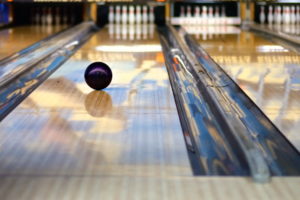When we initially begin bowling, speed may be a consideration lingering in our thoughts, yet it doesn’t command our full attention.
The velocity of the ball significantly impacts its force when striking the pins in bowling. However, are there varying levels of bowling balls, and do these distinctions truly have a substantial impact on the game?

Mastering ball speed control in bowling is a challenging yet rewarding technique. It plays a pivotal role in achieving consistent and higher scores, reflecting a player’s skill in knocking down pins and influencing the game’s dynamics.
Understanding the velocity of a bowling ball and mastering the art of adjusting its speed are vital aspects of a bowler’s strategy. Dive in to discover the typical speeds of bowling balls, techniques for speed adjustment during play, and the significance behind the velocity of a ball in the game.
Contents
Why Does Speed Matter?
Bowling speed plays a vital role in understanding your unique playing style. It reveals insights into your approach as a bowler.
Certain players favor slower, precisely placed shots, while others opt for swift, straight-down-the-line shots that guarantee accuracy.
It ultimately boils down to individual preference, as no single speed reigns supreme. For instance, there are countless scenarios where a player may believe that a forceful and assertive strike is the optimal choice for hitting a target. However, upon execution, they might witness the ball veering into the gutter. A similar outcome occurs when players opt for a slower throw.
Exploring and discovering the optimal technique tailored to your needs is crucial for honing your speed and rhythm.
This concern may not weigh heavily on you if you bowl casually from time to time and prefer not to be overly competitive. Yet, once you identify your favored rhythm, it can significantly enhance your skills as a player.
Moreover, the velocity of a ball significantly influences its behavior upon release. It is essential to consider the speed, especially concerning the lane conditions, whether it is oily or dry, as this factor can determine the ball’s trajectory.
What Is The Average Bowling Ball Speed?
The typical ball speed ranges from 16 to 19 mph. This velocity is commonly used when casually throwing a ball without concentrating on adding excessive or insufficient force, aiming for a straightforward shot down the line.
A standard bowling ball generally reaches the pins in approximately 2.5 seconds, traveling at an initial speed of 16.7 mph, which often increases to nearly 18 mph.
Among professionals, the goal is typically to launch a ball at speeds ranging from 18 to 19 mph. Any velocity below this range is generally regarded as a feeble throw that lacks the force needed to effectively strike the pins.
Slow Ball
A ball traveling under 16 mph is labeled as a slow ball. Despite the initial negative connotation, it offers numerous advantages.
A slower ball experiences less friction, allowing it additional time to hook.
Using a hooked ball can often yield better results than a standard straight strike. Its ability to provide a superior angle at the 1-3 pocket and deliver greater force upon impact leads to improved pin carry.
Ensure that when attempting to hook a ball, you maintain a sufficient speed upon release. Too slow a toss can significantly reduce its effectiveness by the time it reaches the pin, potentially leading it astray into the gutter.
Aim to throw the ball just below the 16 mph threshold to ensure it has the strength needed to knock down the pins effectively.
To execute a slow ball effectively, consider adjusting your position towards the foul line during your approach, starting with a shift of about 2-4 inches.
Ensure consistency in your footwork and synchronize your arm movements with your steps.
Moving closer to the foul line naturally decelerates your stride, as our mental awareness prevents us from crossing the line, thus hindering our momentum and resulting in a slower ball speed, ideal for executing precise hooks.
Another simple method to decelerate a ball involves adjusting the backswing’s height.
Positioning the ball slightly lower in your stance will result in a lower backswing and a slower release speed upon release.
Fast Ball
Any balls traveling above 19 mph are considered fast balls which too have their benefits.
Using a fastball is most effective when aiming for a powerful shot down the middle, especially in the initial part of a frame when scoring a strike is a top priority, avoiding any hooks.
Due to the increased friction generated when throwing a fastball, it becomes more challenging to apply a hook, making it less suitable for curving the ball around.
Trying to hook a faster ball may result in it going straight into the gutter, leading to a rather disappointing throw.

For a direct hit, mastering the technique and muscle power needed to propel the ball swiftly is key. Once you’ve honed these skills, it becomes a winning strategy that almost guarantees strikes with sufficient practice.
To improve your fastball technique, consider starting a bit farther back from the lane than usual. Begin with a few inches of space between you and the starting point. This adjustment will help quicken your stride during the approach, adding extra power and speed to the ball upon release.
To add speed to your fastball, experiment with holding the ball higher than usual in your stance. This adjustment will elevate your backswing, resulting in increased velocity as the ball travels.
Open your shoulders and hips slightly to elevate your arm more effectively when it’s positioned behind you.
Lane Oil Conditions
The lane conditions can affect the ball’s speed, potentially necessitating a slight adjustment in your throwing technique.
Being able to modify your speed based on lane conditions can enhance your adaptability and lead to better scores during gameplay.
The amount of oil applied to a bowling lane determines its condition. When a lane is labeled as ‘wet,’ it indicates an abundance of oil on the surface, significantly impacting the ball’s movement.
On the other hand, a ‘dry’ lane contains minimal oil, impacting friction levels and ball speed.
When a lane is wet and oil-laden, opting for a slower ball speed is ideal. This choice enhances the ball’s chance to hook, rather than skid along the surface.
In drier lanes with minimal oil, faster balls are better suited due to reduced swerving, enabling a more direct strike.
How To Calculate Ball Speed
If you’re interested in knowing how fast you throw a ball, it can be enjoyable to measure it yourself.
This strategy, employed by professionals, offers valuable insights for self-discovery as a player. It helps you assess if adjusting your pace – whether to speed up or slow down – can optimize your performance.
Fortunately, modern automatic scoring systems can now not only track the speed of a ball but also maintain the score for each player accurately.
Many scoreboards offer this feature, providing a convenient quick estimate. However, these devices typically provide only one-speed measurement that is not taken at the point of impact. This limitation makes calculating the overall average speed quite challenging.
A more practical and reliable method involves using a stopwatch, which can precisely measure the time from the release of the bowling ball to the instant it impacts the pins without any technical glitches.
Have a friend on standby with a stopwatch. Ask them to begin timing when you release the ball and stop when it hits the pins.
Repeat this process five times with your friend, measuring the time of each throw separately. Once all five throws are recorded, calculate the average score. Then, input this average into a bowling speed chart, the most accurate tool for predicting ball speeds.
The chart will display your average bowling speed and serve as a valuable tool to pinpoint minor adjustments that could enhance your game.

Does Weight Matter?
The weight of a ball impacts its speed, but the key is using the correct technique. You can throw a small or fastball effectively regardless of its weight.
A heavier ball will roll a bit slower than a lighter one due to the increased energy it imparts. This difference in energy is also why heavier balls have a more forceful impact on the pins when they strike.
Avoid selecting a weight solely based on this. Instead, opt for a ball that feels comfortable to throw. All balls can be thrown swiftly or slowly with practice.
Conclusion
Bowling speed is a key factor that can significantly impact your game performance. It’s important to evaluate your bowling speed with consideration to the specific lane conditions and your competitive level. To enhance your skills, you may find it beneficial to consistently monitor your speed and analyze which technique yields the best results for you.
Fine-tuning your approach based on speed variations, you can optimize your bowling strategy and increase your chances of success on the lanes.

Allow me to introduce myself – I’m Eric Wilkinson, a true bowling aficionado. The world of bowling culture has always fascinated me, and I’ve made the exciting decision to share my passion through writing. As I embark on this blogging adventure, my goal is to provide fellow enthusiasts with valuable insights, tips, and captivating stories. Through my blog, I hope to ignite a deeper appreciation for the sport and foster a sense of community among fellow bowlers. Join me on this thrilling journey as we explore the vibrant world of bowling together.
